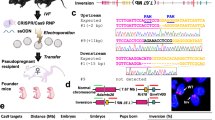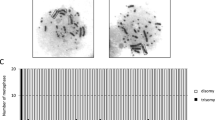Abstract
For introducing regions of human chromosomes greater than a megabase into cells or animals, we have developed a chromosome-cloning system in which defined regions of human chromosomes can be cloned into a stable human minichromosome vector in homologous recombination-proficient chicken DT40 cells. The stable minichromosome vector allowed a 10 Mb-sized region of the mitotically unstable human chromosome 22 to be stably maintained in mouse embryonic stem (ES) cells, and in mice. Furthermore, we demonstrated functional expression of human genes from the HAC in mice. This study describes a stable cloning and expression system for greater than megabase–sized regions of human chromosomes.
This is a preview of subscription content, access via your institution
Access options
Subscribe to this journal
Receive 12 print issues and online access
$209.00 per year
only $17.42 per issue
Buy this article
- Purchase on Springer Link
- Instant access to full article PDF
Prices may be subject to local taxes which are calculated during checkout





Similar content being viewed by others
References
Shizuya, H. et al. Cloning and stable maintenance of 300-kilobase-pair fragments of human DNA in Escherichia coli using an F-factor-based vector. Proc. Natl. Acad. Sci. USA 89, 8794–8797 (1992).
Sternberg, N. Bacteriophage P1 cloning system for the isolation, amplification, and recovery of DNA fragments as large as 100 kilobase pairs. Proc. Natl. Acad. Sci. USA 87, 103–107 (1990).
Burke, D.T., Carle, G.F. & Olson, M.V. Cloning of large segments of exogenous DNA into yeast by means of artificial chromosome vectors. Science 236, 806–813 (1987).
Green, E.D., Riethman, H.C., Dutchik, J.E. & Olson, M.V. Detection and characterization of chimeric yeast artificial-chromosome clones. Genomics 11, 658–669 (1991).
Harrington, J.J., Bokkelen, G.V., Mays, R.W., Gustashaw, K. & Willard, H.F. Formation of de novo centromeres and construction of first-generation human artificial microchromosomes. Nat. Genet. 15, 345–355 (1997).
Shen, M.H., Yang, J., Loupart, M.-L., Smith, A. & Brown, W. Human mini-chromosomes in mouse embryonal stem cells. Hum. Mol. Genet. 6, 1375–1382 (1997).
Ikeno, M. et al. Construction of YAC-based mammalian artificial chromosomes. Nat. Biotechnol. 16, 431–439 (1998).
Mill, W., Cricher, R., Lee, C. & Farr, C. J. Generation of an ∼4 Mb human X centromere-based minichromosome by targeted telomere-associated chromosome fragmentation in DT40. Hum. Mol. Genet. 8, 751–761 (1999).
Szeles, T.H. et al. Stability of a functional murine satellite DNA-based artificial chromosome across mammalian species. Chromosome Res. 7, 3–7 (1999).
Grimes, B. & Cooke, H. Engineering mammalian chromosomes. Hum. Mol. Genet. 7, 1635–1640 (1998).
Kelleher, Z. et al. First-generation mouse artificial episomal chromosomes for shuttling 100 KB human DNA in mouse cells. Nat. Biotechnol. 16, 762–768 (1998).
Co, D.O. et al. Generation of transgenic mice and germline transmission of a mammalian artificial chromosome introduced into embryos by pronuclear microinjection. Chromosome Res. 8, 183–191 (2000).
Tomizuka, K. et al. Functional expression and germline transmission of a human chromosome fragment in chimaeric mice. Nat. Genet. 16, 133–143 (1997).
Tomizuka, K. et al. Double trans-chromosomic mice: maintenance of two individual human chromosome fragments containing immunogobulin heavy and kappa loci and expression of fully human antibodies. Proc. Natl. Acad. Sci. USA 97, 722–727 (2000).
Smith, A. J. H. et al. A site-directed chromosomal translocation induced in embryonic stem cells by Cre-loxP recombination. Nat. Genet. 9, 376–384 (1995).
Kuroiwa, Y. et al. Efficient modification of a human chromosome by telomere-directed truncation in high homologous recombination-proficient chicken DT40 cells. Nucleic Acid Res. 26, 3447–3448 (1998).
Dieken, E.S., Epner, E.M., Fiering, S., Fournier, R.E.K. & Groudine, M. Efficient modification of human chromosomal alleles using recombination-proficient chicken/human microcell hybrids. Nat. Genet. 12, 174–182 (1996).
Worton, R.G. et al. Human ribosomal RNA genes: orientation of the tandem array and conservation of the 5′ end. Science 239, 64–68 (1988).
Dunham, I. et al. The DNA sequence of human chromosome 22. Nature 402, 489–495 (1999).
Deursen, J.V., Fornerod, M., Rees, B.V. & Grosveld, G. Cre-mediated site-specific translocation between nonhomologous mouse chromosomes. Proc. Natl. Acad. Sci. USA 92, 7376–7380 (1995).
Kuppers, J.B, Zocher, I., Thiebe, R. & Zachau, H.G. The human immunoglobulin κ locus on yeast artificial chromosomes (YACs). Gene 191, 173–181 (1997).
Weichhold, G.M., Huber, C., Parnes, J.R. & Zachau, H.G. The CD8α locus is located on the telomere side of the immunoglobulin κ locus at a distance of 2Mb. Genomics 16, 512–514 (1993).
Su, H., Wang, X. & Bradley, A. Nested chromosomal deletions induced with retroviral vectors in mice. Nat. Genet. 24, 92–95 (2000).
Loupart, M.L., Shen, M.H. & Smith, A. Differential stability of a human mini-chromosome in mouse cell lines. Chromosome 107, 255–259 (1998).
Honjo, T. & Alt, F.W. Immunoglobulin genes, Edn. 2. (Academic Press, San Diego, CA; 1995).
Abuin, A., & Bradley, A. Recycling selectable markers in mouse embryonic stem cells. Mol. Cell. Biol. 16, 1851–1856 (1996).
Yagi, T. et al. Homologous recombination at c-fyn locus of mouse embryonic stem cells with use of diphtheria toxin A-fragment gene in negative selection. Proc. Natl. Acad. Sci. USA 87, 9918–9922 (1990).
Mortensen, R.M., Conner, D.A., Chao, S., Geisterfer-Lowrance, A.A. & Seidman, J.G. Production of homozygous mutant ES cells with a single targeting construct. Mol. Cell. Biol. 12, 2391–2395 (1992).
Acknowledgements
We thank Dr. Shun-ichi Takeda for technical advice and valuable discussion; Saori Suzuki and Sumiko Igami for technical assistance.
Author information
Authors and Affiliations
Corresponding author
Rights and permissions
About this article
Cite this article
Kuroiwa, Y., Tomizuka, K., Shinohara, T. et al. Manipulation of human minichromosomes to carry greater than megabase-sized chromosome inserts. Nat Biotechnol 18, 1086–1090 (2000). https://doi.org/10.1038/80287
Received:
Accepted:
Issue Date:
DOI: https://doi.org/10.1038/80287
This article is cited by
-
Nannochloropsis artificial chromosomes (NannoACs) loom on the horizon
Journal of Oceanology and Limnology (2023)
-
Efficient human-like antibody repertoire and hybridoma production in trans-chromosomic mice carrying megabase-sized human immunoglobulin loci
Nature Communications (2022)
-
Construction of stable mouse artificial chromosome from native mouse chromosome 10 for generation of transchromosomic mice
Scientific Reports (2021)
-
CRISPR/Cas9-induced transgene insertion and telomere-associated truncation of a single human chromosome for chromosome engineering in CHO and A9 cells
Scientific Reports (2017)
-
A pathway from chromosome transfer to engineering resulting in human and mouse artificial chromosomes for a variety of applications to bio-medical challenges
Chromosome Research (2015)



